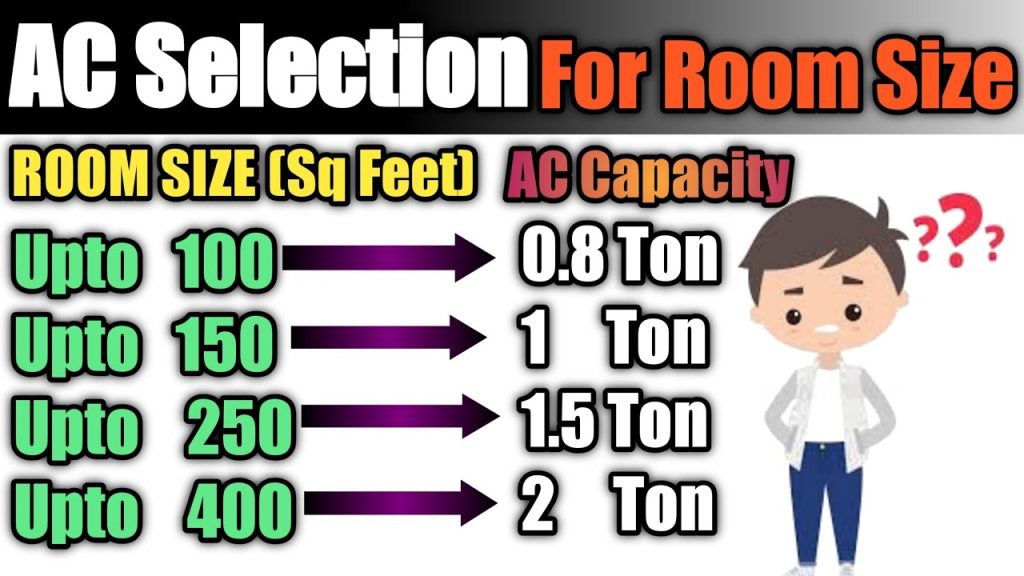Well, before you buy an air conditioner for your home, read this post as it will assist you in determining the appropriate AC Capacity for your location in order to get the ideal temperature inside the house.
When considering the size of an air conditioner, consider its physical dimensions and its AC capacity measured in BTUs (British Thermal Units). One may always hope for the most efficient air conditioner model with the lowest running cost, which occurs when you select an air conditioner after studying the size of the space to be cooled. When purchasing an air conditioner, determine the room’s square footage by multiplying the length and breadth of the space.


How to determine your AC Capacity?
To determine the precise capacity AC, multiply the length by the breadth of the available area and then multiply that sum by 25 BTU. Here is how you may select an all-season air conditioner that provides adequate cooling on wet, humid, or scorching sunny days. The actual room size is 100 square feet if the space is 10 feet wide and 10 feet long. It implies the air conditioner with a cooling capacity of 100*25=2500 BTUs is the best match for your available space.
Consumers were generally torn between getting a smaller or larger air conditioner and deciding which would function best. Units with lower BTUs Air conditioners take longer to cool a space, and higher capacity will raise your power bill while cooling the room faster. Ask yourself whether one provides the finest cooling with the least energy consumption, or get assistance from an authorized air conditioner service to select the best-suited one.
How to Choose an AC Capacity and Model?
After determining the appropriate capacity, the next step is to select the model, as wall-mounted air conditioners are considerably superior to window ACs in terms of cooling speed and efficiency. The wall-mounted air conditioner is normally set somewhat higher than the window because it does a better job of agitating the interior air and therefore provides superior cooling. The space between the floor and the wall-mounted air conditioner filters air from high to low points, resulting in consistent cooling.
The thermostat is also important in effective cooling since the higher the thermostat, the better an air conditioner cools. It is also necessary to provide a better exhaust to an air conditioner in order to obtain fresh air at all times and to better neutralize the interior temperature and humidity. Recent technology air conditioners have newer characteristics that allow them to better adapt to their surroundings and self-control the cooling and other elements.
What Impact Can Energy Efficiency Ratings Have in Determining AC Capacity?
When it comes to purchasing an energy-efficient air conditioner, the star rating is quite important since the higher the star rating, the less power it consumes. When it is necessary to run the air conditioner throughout the day and night, a 5-star air conditioner is essential to reduce energy usage. A three-star rated air conditioner is also suitable for someone who just needs AC for a few hours.
1,000 watts=1-ton cooling
1,500 watts=1.5-ton cooling
2,000 watts = 2-ton cooling
3000 watts= 3-ton cooling
Here is a blog using which you can Transform your old AC into a new like AC!
Factors Influencing an Air Conditioner’s Power Efficiency
1. The number of people present in the room
Because the human body generates a lot of heat during daily activities, a room with more than 10 people requires a larger size AC or more than one AC to provide enough cooling, but a room with fewer people may get by with a single AC. As a result, more people in the area necessitate the use of an air conditioner to chill the room, resulting in an electrical expense.
2. Temperatures on the outside and inside
When the outside temperature is above 40 degrees Celsius, it requires more power to cool a room than when the temperature is 32 degrees Celsius. Similarly, cooling a room below 18 degrees Celsius requires more electricity than cooling it at 24 degrees Celsius at the same time.
The real room size: air conditioners remove all of the heat from your room because the larger the space, the larger the air within the room, and the more power necessary to chill all of the inside air. The total power spent in removing heat from a space of less than 100 square feet is less than that consumed in removing heat from a room larger than 100 square feet.
3. More Electrical Devices in the Room
The electrical equipment in your room creates heat, which raises the temperature inside your room and forces your air conditioner to work harder to chill the same volume of air, consuming more electricity for cooling.
The volume of air that must be cooled: We frequently leave the room door open, which increases the volume of air within the room and necessitates the use of the AC to cool it. Now your air conditioner must cool the additional hot air entering the room, putting undue strain on the machine and consuming additional electricity to accomplish maximum cooling.
4. More Items in the Room
While your AC is on, every hard surface in your room becomes chilly; this consumes part of the cooling your AC needs to accomplish.



